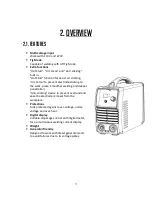
7
WELDING SPARKS can cause fire or explosion.
Welding on closed containers, such as tanks, drums, or pipes, can cause them to explode. Flying
sparks from the welding arc, hot work piece, and hot equipment can cause fires and burns.
Accidental contact of electrode to metal objects can cause sparks, explosion, overheating, or fire.
Check and be sure the area is safe before doing any welding.
Remove fire hazards material from the welding area. If this is not possible, cover them to
prevent the welding sparks from starting a fire. Remember that welding sparks and hot
materials from welding can easily go through small cracks and openings to adjacent areas.
Avoid welding near hydraulic lines. Have a fire extinguisher readily available.
Where compressed gases are to be used at the job site, special precautions should be used
to prevent hazardous situation.
When not welding, make certain no part of the electrode circuit is touching the work or
ground. Accidental contact can cause overheating and create a fire hazard.
Do not heat, cut or weld tanks, drums or containers until the proper steps have been
taken to insure that such procedures will not cause flammable or toxic vapors from
substances inside. They can cause an explosion even though they have been “cleaned”.
Vent hollow castings or containers before heating, cutting or welding. They may explode.
Sparks and spatter are thrown from the welding arc. Wear oil free protective garments
such as leather gloves, heavy shirt, cuff less trousers, high shoes and a cap over your hair.
Wear earplugs when welding out of position or in confined places. Always wear safety
glasses with side shields when in a welding area.
Connect the work cable to the work as close to the welding area as practical. Work cables
connected to the building framework or other locations away from the welding area
increase the possibility of the welding current passing through lifting chains, crane cables
or other alternate circuits. This can create fire hazards or overheat lifting chains or cables
until they fail.
Rotating parts may be dangerous.
Use only compressed gas cylinders containing the correct shielding gas for the process
used and properly operating regulators designed for the gas and pressure used. All hoses,
fittings, etc. should be suitable for the application and maintained in good condition.
Always keep cylinders in an upright position securely chained to an undercarriage or fixed
support.
Cylinders should be located:
-
Away from areas where they may be struck or subjected to physical damage.
-
At a safe distance from arc welding or cutting operations and any other source of heat,
sparks, or flame.
Содержание Ronch Weld 160ARC DV
Страница 1: ...1 SERIES 160ARC DV 200ARC DV STICK TIG ...
Страница 35: ...35 4 4 Electrical schematic drawing ...
Страница 36: ...36 200ARC DV STICK TIG ...








































